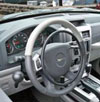|
Lectures |
| Week
1 |
Week
2 |
Week
3 |
Week
4 |
Week
5 |
Week
6 |
Week
7 |
Week
8 |
Week
9 |
Week
10 |
|
|
|
|
|
|
|
|
|
|
|
Thursday, February
4th
|

|
Assistive Technology
Faire
|
Abstract: This event will
provide an opportunity for students and community members to get an up-close
look at a variety of devices and learn about available programs from product
vendors and service agencies. Please browse to the Call
for Assistive Technology Faire Participants webpage if you would like to
participate in this event as a vendor of assistive technology products or
services. Everyone is welcome to attend the faire.
Vendor Participants:
|

|
Life
Glider™
Life Glider™ - Rob
Karlovich
The Life Glider™ is an
innovative walking aide with a unique hands-free support feature for people
with balance and weight-bearing challenges. It enables users to stand and walk
safely and comfortably for extended periods while engaged in everyday
activities such cooking and grocery shopping. |
|

|
Service Dog
Training
Service Dog Tutor - Jean Cary and
Service Dog Ranger
Service Dog Tutor
adapts clients' own dogs to do specific service tasks for their owners. Clients
include seniors and children who have mobility and balance challenges as well
as cognitive disabilities. |
|

|
Digital Accelerator
Ring and the Main Hand Brake
Kempf -
Martine Kempf
The Digital Accelerator Ring and
the Main Hand Brake are hand controls that can be installed on most cars
with automatic transmissions to allow a person who has lost the use of both
legs to drive with both hands on the steering wheel. |
|

|
Podna Rover
Podna
Designs - Elaine Levin
The Podna Rover
is an innovative all-terrain mobility device for individuals who need
additional support to maintain balance or stability while walking. The device
offers confidence to outdoor travelers over gravel, uneven surfaces, and
inclines. It features compliant wheels, a self-centering frame, a suspension to
soak up bumps, and self-locking brakes. |
|

|
Whill
Wheelchair Not
Attending
Whill, Inc. - Chris Koyama
The Whill is an omnidirectional four-wheel-drive
mobility device meant to give wheelchair users a sleek alternative to standard
chairs, which many believe reinforce stereotypes of weakness or helplessness.
The product recently received the
Good Design Grand
Award. |
|

|
Eyefluence’s
Eye-interaction Platform
Eyefluence - Peter Milford
Eyefluence’s
eye-interaction platform provides technology that can be integrated
into any head mounted device to realize the potential for wearable computing by
connecting your brain to the internet through your eyes. Head-mounted displays
equipped with Eyefluence's eye-interaction technology have the potential to
expand human intelligence, enhance social interaction, and revolutionize
entertainment. |
|

|
Beyond Exoskeletons -
Wearable Exosuit Technologies
SRI International - Roy Kornbluh
SRI is developing wearable "exosuits" that can augment the
musculoskeletal system for performance and strength enhancement and assistance
to overcome or prevent damage from injury or disease. SRI's exosuit differs
from exoskeletons by using new muscle-like actuation, comfortable and soft skin
attachment, and electronically releasable spring elements to minimize mass,
bulk, and noise. As part of DARPA's
Warrior
Web program, the technology is being applied to prevent and reduce
musculoskeletal injuries caused by dynamic events typically found in the
warfighter’s environment. We are exploring other military applications and
beginning to use the technologies to assist individuals with musculoskeletal
disease. |
|


|
Robot Guide &
Ultrasonic White Cane
Intellisight - Brian Higgins
The Robot Guide is a 7th generation prototype that
employs three ultrasonic sensors and a LIDAR range sensor while the
Ultrasonic White Cane incorporates one ultrasonic sensor. Both devices
use a Bluetooth bone conduction headset to provide audio feedback about objects
in the walking path, enhancing guidance and navigation for blind
travelers. |
|

|
Assistive Technology
Device Lending Library
Silicon Valley Independent Living Center - Joe
Escalante
Silicon Valley Independent Living
Center (SVILC) is a cross-disability, intergenerational, and multicultural
disability justice organization that creates fully inclusive communities that
value the dignity, equality, freedom and worth of every human being. SVILC
maintains a
lending
library of assistive technology so consumers may borrow a device free of
charge and try it before buying it, use it to compare similar devices, or to
use while a personal device is being repaired. |
|

|
Accessible Voting
Machine
IDEO - Albert Leung
IDEO designers created a
voting system that
addresses the complexities unique to Los Angles' voter base, including its
vastly diverse population and its myriad election laws and policies. The goal
is to build a system that would be useful and accessible to voters of all ages,
backgrounds, and disabilities: those who are vision and hearing impaired, use
wheelchairs, have learning disabilities, are unfamiliar with technology, and
speak languages other than English. |
|

|
Autism Glass
The
Autism Glass Project at Stanford Medicine - Beth McCarthy & Jena
Daniels
The project uses Google Glass to help
people with Autism Spectrum Disorder understand social cues and aid the
behavioral therapy treatment process. Using a custom eye tracking infrared
camera and Glass's head motion tracking sensors and microphone, the software
analyzes the wearer's behavior when interacting with others, displays real time
social cues about facial expressions (i.e. "interested," "frustrated," etc),
and records the amount and type of eye contact made. |
|

|
Product or
Service
Vendor -
Participants
Product
description |
- Assistive Technology Faire
Material:
- Photos - 1.92 Mb pdf file
- Brochures:
- Kempf-Darios - 2.81 Mb pdf file
- SRI
- Robotics - 192 Kb pdf file
- Tauris - 191 Kb pdf file
- Wearable Exosuit
Technologies - 329 Kb pdf file
- Autism Glass Project - 502Kb pdf
file
- Service Dog Tutor - 488 Kb pdf
file
|